Spatial Prioritization for the Zonation of a Reef System in a New Remote Marine Protected Area in the Southern Gulf of Mexico
Abstract
1. Introduction
2. Materials and Methods
2.1. Study Area
2.2. Image Pre-Processing
2.3. Habitat Characterization and Benthic Habitat Thematic Map Conservation
2.4. Seascape Metrics and Spatial Change
- pij: perimeter (m) of patch j from the class i.
- aij: area (m2) of the patch j.
- hij: distance (m) from patch ij to the nearest patch belonging to the same class.
- SHAPE: Patch shape
- ENN: Euclidean nearest neighbor.
- Bd: β-diversity.
- H: number of habitats within the sample area (window).
- Dij: Dissimilarity coefficient between habitat i and habitat j.
- Pi: Proportion of window compromised of habitat i.
2.5. Selection of Priority Conservation Areas
3. Results
3.1. Benthic Habitat Thematic Map and Seascape Metrics
3.2. Selection of Priority Areas for Conservation
4. Discussion
4.1. Seascape Metrics
4.2. Priority Areas for Conservation
4.3. Implications for Conservation
5. Conclusions
Supplementary Materials
Author Contributions
Funding
Institutional Review Board Statement
Data Availability Statement
Acknowledgments
Conflicts of Interest
References
- Lau, J.D.; Hicks, C.C.; Gurney, G.G.; Cinner, J.E. Disaggregating Ecosystem Service Values and Priorities by Wealth, Age, and Education. Ecosyst. Serv. 2018, 29, 91–98. [Google Scholar] [CrossRef]
- Moberg, F.; Folke, C. Ecological Goods and Services of Coral Reef Ecosystems. Ecol. Econ. 1999, 29, 215–233. [Google Scholar] [CrossRef]
- Downs, C.A.; Woodley, C.M.; Richmond, R.H.; Lanning, L.L.; Owen, R. Shifting the Paradigm of Coral-Reef ‘Health’ Assessment. Mar. Pollut. Bull. 2005, 51, 486–494. [Google Scholar] [CrossRef]
- Jones, G.P.; McCormick, M.I.; Srinivasan, M.; Eagle, J.V. Coral Decline Threatens Fish Biodiversity in Marine Reserves. Proc. Natl. Acad. Sci. USA 2004, 101, 8251–8253. [Google Scholar] [CrossRef]
- Hughes, T.P.; Baird, A.H.; Bellwood, D.R.; Card, M.; Connolly, S.R.; Folke, C.; Grosberg, R.; Hoegh-Guldberg, O.; Jackson, J.B.C.; Kleypas, J.; et al. Climate Change, Human Impacts, and the Resilience of Coral Reefs. Science 2003, 301, 929–933. [Google Scholar] [CrossRef] [PubMed]
- Hoegh-Guldberg, O.; Mumby, P.J.; Hooten, A.J.; Steneck, R.S.; Greenfield, P.; Gomez, E.; Harvell, C.D.; Sale, P.F.; Edwards, A.J.; Caldeira, K.; et al. Coral Reefs Under Rapid Climate Change and Ocean Acidification. Science 2007, 318, 1737–1742. [Google Scholar] [CrossRef] [PubMed]
- Pandolfi, J.M.; Bradbury, R.H.; Sala, E.; Hughes, T.P.; Bjorndal, K.A.; Cooke, R.G.; McArdle, D.; McClenachan, L.; Newman, M.J.H.; Paredes, G.; et al. Global Trajectories of the Long-Term Decline of Coral Reef Ecosystems. Science 2003, 301, 955–958. [Google Scholar] [CrossRef] [PubMed]
- Cruz Vázquez, C.; Rioja Nieto, R.; Enriquez, C. Spatial and Temporal Effects of Management on the Reef Seascape of a Marine Protected Area in the Mexican Caribbean. Ocean Coast. Manag. 2019, 169, 50–57. [Google Scholar] [CrossRef]
- Rioja Nieto, R.; Barrera Falcón, E.; Hinojosa Arango, G.; Riosmena Rodríguez, R. Benthic Habitat β-Diversity Modeling and Landscape Metrics for the Selection of Priority Conservation Areas Using a Systematic Approach: Magdalena Bay, Mexico, as a Case Study. Ocean Coast. Manag. 2013, 82, 95–103. [Google Scholar] [CrossRef]
- Jones, G.; Srinivasan, M.; Almany, G. Population Connectivity and Conservation of Marine Biodiversity. Oceanography 2007, 20, 100–111. [Google Scholar] [CrossRef]
- Eggertsen, L.; Goodell, W.; Cordeiro, C.A.M.M.; Cossa, D.; De Lucena, M.; Berkström, C.; Franco, J.N.; Ferreira, C.E.L.; Bandeira, S.; Gullström, M. Where the Grass Is Greenest in Seagrass Seascapes Depends on Life History and Simple Species Traits of Fish. Estuar. Coast. Shelf Sci. 2022, 266, 107738. [Google Scholar] [CrossRef]
- Abecasis, D.; Fragkopoulou, E.; Claro, B.; Assis, J. Biophysical Modelling and Graph Theory Identify Key Connectivity Hubs in the Mediterranean Marine Reserve Network. Front. Mar. Sci. 2023, 9, 1000687. [Google Scholar] [CrossRef]
- Liu, R.; Wang, Q.; Kong, H.; Li, Y. Priority Protected Areas for Mangrove Conservation in Coastal Guangdong, China: Addressing Climate and Land Cover Changes. Ocean Coast. Manag. 2025, 267, 107707. [Google Scholar] [CrossRef]
- Mumby, P.J. Connectivity of Reef Fish between Mangroves and Coral Reefs: Algorithms for the Design of Marine Reserves at Seascape Scales. Biol. Conserv. 2006, 128, 215–222. [Google Scholar] [CrossRef]
- Toledo, V.M. Repensar La Conservación: ¿áreas Naturales Protegidas o Estrategia Bioregional? Gac. Ecológica 2005, 77, 67–83. [Google Scholar]
- Nelson, J.; Bradner, H. The Case for Establishing Ecosystem-Scale Marine Reserves. Mar. Pollut. Bull. 2010, 60, 635–637. [Google Scholar] [CrossRef] [PubMed]
- Leenhardt, P.; Cazalet, B.; Salvat, B.; Claudet, J.; Feral, F. The Rise of Large-Scale Marine Protected Areas: Conservation or Geopolitics? Ocean Coast. Manag. 2013, 85, 112–118. [Google Scholar] [CrossRef]
- Antonio Puppim De Oliveira, J. Implementing Environmental Policies in Developing Countries Through Decentralization: The Case of Protected Areas in Bahia, Brazil. World Dev. 2002, 30, 1713–1736. [Google Scholar] [CrossRef]
- Bezaury-Creel, J.E. Protected Areas and Coastal and Ocean Management in México. Ocean Coast. Manag. 2005, 48, 1016–1046. [Google Scholar] [CrossRef]
- Rioja Nieto, R.; Álvarez Filip, L. Coral Reef Systems of the Mexican Caribbean: Status, Recent Trends and Conservation. Mar. Pollut. Bull. 2019, 140, 616–625. [Google Scholar] [CrossRef]
- Bobadilla, M.; Alvarez-Borrego, S.; Avila-Foucat, S.; Lara-Valencia, F.; Espejel, I. Evolution of Environmental Policy Instruments Implemented for the Protection of Totoaba and the Vaquita Porpoise in the Upper Gulf of California. Environ. Sci. Policy 2011, 14, 998–1007. [Google Scholar] [CrossRef]
- Edgar, G.J.; Stuart-Smith, R.D.; Willis, T.J.; Kininmonth, S.; Baker, S.C.; Banks, S.; Barrett, N.S.; Becerro, M.A.; Bernard, A.T.F.; Berkhout, J.; et al. Global Conservation Outcomes Depend on Marine Protected Areas with Five Key Features. Nature 2014, 506, 216–220. [Google Scholar] [CrossRef] [PubMed]
- Teh, L.C.L.; Teh, L.S.L.; Pitcher, T.J. A Tool for Site Prioritisation of Marine Protected Areas under Data Poor Conditions. Mar. Policy 2012, 36, 1290–1300. [Google Scholar] [CrossRef]
- Wood, L.J.; Dragicevic, S. GIS-Based Multicriteria Evaluation and Fuzzy Sets to Identify Priority Sites for Marine Protection. Biodivers. Conserv. 2007, 16, 2539–2558. [Google Scholar] [CrossRef]
- Ortiz Cajica, A.K.; Hinojosa-Arango, G.; Garza-Pérez, J.R.; Rioja-Nieto, R. Seascape Metrics, Spatio-Temporal Change, and Intensity of Use for the Spatial Conservation Prioritization of a Caribbean Marine Protected Area. Ocean Coast. Manag. 2020, 194, 105265. [Google Scholar] [CrossRef]
- Pittman, S.J.; Poti, M.; Jeffrey, C.F.G.; Kracker, L.M.; Mabrouk, A. Decision Support Framework for the Prioritization of Coral Reefs in the U.S. Virgin Islands. Use Spat. Ecol. Conserv. 2018, 47, 26–34. [Google Scholar] [CrossRef]
- Stelzenmüller, V.; Lee, J.; South, A.; Foden, J.; Rogers, S.I. Practical Tools to Support Marine Spatial Planning: A Review and Some Prototype Tools. Mar. Policy 2013, 38, 214–227. [Google Scholar] [CrossRef]
- Possingham, H.; Wilson, K.; Andelman, S.; Vynne, C. Protected Areas: Goals, Limitations, and Design. In Principles of Conservation Biology; Groom, M., Meefe, G., Carrol, C., Eds.; Sinauer Associates, Inc.: Sunderland, MA, USA, 2006; pp. 509–533. [Google Scholar]
- Ball, I.R.; Possingham, H.P.; Watts, M.E. Marxan and Relatives: Software for Spatial Conservation Prioritization. In Spatial Conservation Prioritization; Moilanen, A., Wilson, K.A., Possingham, H.P., Eds.; Oxford University Press: Oxford, UK, 2009; pp. 185–195. ISBN 978-0-19-954776-0. [Google Scholar]
- Moilanen, A.; Franco, A.M.A.; Early, R.I.; Fox, R.; Wintle, B.; Thomas, C.D. Prioritizing Multiple-Use Landscapes for Conservation: Methods for Large Multi-Species Planning Problems. Proc. R. Soc. B Biol. Sci. 2005, 272, 1885–1891. [Google Scholar] [CrossRef]
- Mir, A.H.; Sarma, K.; Upadhaya, K. Assessing the Effectiveness of Community Managed Forests for Plant Diversity Conservation in Meghalaya, Northeast India. Plant Divers. 2022, 44, 243–254. [Google Scholar] [CrossRef]
- Ghoneim, S.M.; Yehia, M.A.; Salem, S.M.; Ali, H.F. Integrating Remote Sensing Data, GIS Analysis and Field Studies for Mapping Alteration Zones at Wadi Saqia Area, Central Eastern Desert, Egypt. Egypt. J. Remote Sens. Space Sci. 2022, 25, 323–336. [Google Scholar] [CrossRef]
- Ranith, R.; Senthilnathan, L.; Machendiranathan, M.; Thangaradjou, T.; Sasamal, S.K.; Choudhury, S.B. Mapping Sites of Reef Vulnerability along Lagoons of Lakshadweep Archipelago, Indian Ocean. Environ. Monit. Assess. 2017, 189, 494. [Google Scholar] [CrossRef]
- Boström, C.; Pittman, S.; Simenstad, C.; Kneib, R. Seascape Ecology of Coastal Biogenic Habitats: Advances, Gaps, and Challenges. Mar. Ecol. Prog. Ser. 2011, 427, 191–217. [Google Scholar] [CrossRef]
- Pittman, S.J.; Monaco, M.E.; Friedlander, A.M.; Legare, B.; Nemeth, R.S.; Kendall, M.S.; Poti, M.; Clark, R.D.; Wedding, L.M.; Caldow, C. Fish with Chips: Tracking Reef Fish Movements to Evaluate Size and Connectivity of Caribbean Marine Protected Areas. PLoS ONE 2014, 9, e96028. [Google Scholar] [CrossRef] [PubMed]
- Swanborn, D.J.B.; Huvenne, V.A.I.; Pittman, S.J.; Woodall, L.C. Bringing Seascape Ecology to the Deep Seabed: A Review and Framework for Its Application. Limnol. Oceanogr. 2022, 67, 66–88. [Google Scholar] [CrossRef]
- Weeks, R. Incorporating Seascape Connectivity in Conservation Prioritisation. PLoS ONE 2017, 12, e0182396. [Google Scholar] [CrossRef]
- Pittman, S.; Yates, K.; Bouchet, P.; Alvarez-Berastegui, D.; Andréfouët, S.; Bell, S.; Berkström, C.; Boström, C.; Brown, C.; Connolly, R.; et al. Seascape Ecology: Identifying Research Priorities for an Emerging Ocean Sustainability Science. Mar. Ecol. Prog. Ser. 2021, 663, 1–29. [Google Scholar] [CrossRef]
- Ashtab, D.; Gholamalifard, M.; Jokar, P.; Kostianoy, A.G.; Semenov, A.V. Spatial Planning of Marine Protected Areas (MPAs) in the Southern Caspian Sea: Comparison of Multi-Criteria Evaluation (MCE) and Simulated Annealing Algorithm. J. Mar. Sci. Eng. 2024, 12, 123. [Google Scholar] [CrossRef]
- Cuevas, E.; Uribe-Martínez, A.; Morales-Ojeda, S.M.; Gómez-Ruíz, P.A.; Núñez-Lara, E.; Teutli-Hernández, C.; Herrera-Silveira, J.A. Spatial Configuration of Seagrass Community Attributes in a Stressed Coastal Lagoon, Southeastern Gulf of Mexico. Reg. Stud. Mar. Sci. 2021, 48, 102049. [Google Scholar] [CrossRef]
- Harborne, A.R.; Mumby, P.J.; Żychaluk, K.; Hedley, J.D.; Blackwell, P.G. Modeling the Beta Diversity of Coral Reefs. Ecology 2006, 87, 2871–2881. [Google Scholar] [CrossRef] [PubMed]
- Andréfouët, S.; Muller-Karger, F.E.; Hochberg, E.J.; Hu, C.; Carder, K.L. Change Detection in Shallow Coral Reef Environments Using Landsat 7 ETM+ Data. Remote Sens. Environ. 2001, 78, 150–162. [Google Scholar] [CrossRef]
- Kabiri, K.; Pradhan, B.; Samimi-Namin, K.; Moradi, M. Detecting Coral Bleaching, Using QuickBird Multi-Temporal Data: A Feasibility Study at Kish Island, the Persian Gulf. Estuar. Coast. Shelf Sci. 2013, 117, 273–281. [Google Scholar] [CrossRef]
- Shapiro, A.; Rohmann, S. Summit-to-Sea Mapping and Change Detection Using Satellite Imagery: Tools for Conservation and Management of Coral Reefs. Rev. Biol. Trop. 2005, 53, 185–193. [Google Scholar] [PubMed]
- Shapiro, A.C.; Rohmann, S.O. Mapping Changes in Submerged Aquatic Vegetation Using Landsat Imagery and Benthic Habitat Data: Coral Reef Ecosystem Monitoring in Vieques Sound between 1985 and 2000. Bull. Mar. Sci. 2006, 79, 375–388. [Google Scholar]
- Zacharias, M.A.; Gregr, E.J. Sensitivity and Vulnerability in Marine Environments: An Approach to Identifying Vulnerable Marine Areas. Conserv. Biol. 2005, 19, 86–97. [Google Scholar] [CrossRef]
- Dobson, J.E. NOAA Coastal Change Analysis Program (C-CAP): Guidance for Regional Implementation; U.S. Department of Commerce: Seattle, DC, USA, 1995. [Google Scholar]
- Pittman, S.J.; Connor, D.W.; Radke, L.; Wright, D.J. 1.09—Application of Estuarine and Coastal Classifications in Marine Spatial Management. In Treatise on Estuarine and Coastal Science; Wolanski, E., McLusky, D., Eds.; Academic Press: Waltham, MA, USA, 2011; pp. 163–205. ISBN 978-0-08-087885-0. [Google Scholar]
- Pittman, S.J.; Swanborn, D.J.B.; Connor, D.W.; Wright, D.J. Application of Estuarine and Coastal Classifications in Marine Spatial Management. In Treatise on Estuarine and Coastal Science, 2nd ed.; Elsevier: Amsterdam, The Netherlands, 2024; pp. 205–276. ISBN 978-0-323-91042-2. [Google Scholar]
- Selig, E.R.; Bruno, J.F. A Global Analysis of the Effectiveness of Marine Protected Areas in Preventing Coral Loss. PLoS ONE 2010, 5, e9278. [Google Scholar] [CrossRef]
- Bellwood, D.R.; Pratchett, M.S.; Morrison, T.H.; Gurney, G.G.; Hughes, T.P.; Álvarez-Romero, J.G.; Day, J.C.; Grantham, R.; Grech, A.; Hoey, A.S.; et al. Coral Reef Conservation in the Anthropocene: Confronting Spatial Mismatches and Prioritizing Functions. Biol. Conserv. 2019, 236, 604–615. [Google Scholar] [CrossRef]
- Jordán-Dahlgren, E.; Rodríguez-Martínez, R.E. The Atlantic Coral Reefs of Mexico. In Latin American Coral Reefs; Elsevier: Amsterdam, The Netherlands, 2003; pp. 131–158. ISBN 978-0-444-51388-5. [Google Scholar]
- Busby, R.F. Sediments and Reef Corals of Cayo Arenas, Campeche Bank, Yucatán, Mexico; US Naval Oceanographic Office: Hancock, MS, USA, 1965; Volume 187. [Google Scholar]
- Logan, B.W.; Bass, M.N.; Cebulski, D.E. Carbonate Sediments and Reefs, Yucatán Shelf, Mexico; McBirney, A.R., Ed.; American Association of Petroleum Geologists: Tulsa, OK, USA, 1969. [Google Scholar]
- Gobierno de México. DECRETO por el que se Declara Área Natural Protegida Arrecifes del Golfo de México-Sur, con la Categoría de Parque Nacional, la Superficie de 4,109,731-42-56.09 Hectáreas, Ubicada en el Golfo de México; Diario Oficial de la Federación: Cuauhtémoc, México, 2024. [Google Scholar]
- Cabrera Rivera, E.; Molina-Hernández, A.; Medellín-Maldonado, F.; Guendulain-García, S.; Pérez-Cervantes, E.; Rioja-Nieto, R.; Medina-Valmaseda, A.E.; Alvarez-Filip, L. Night surveys reveal abundant populations of sea urchins with high erosive potential in Cayo Arenas, Banco de Campeche. Cienc. Mar. 2025, 50, e3508. [Google Scholar] [CrossRef]
- Chávez, H. Peces colectados en el arrecife Triángulos Oeste y en cayo Arenas, Sonda de Campeche, México. Acta Zool. Mex. 1966, 8, 1–12. [Google Scholar]
- Chavez, P.S. An Improved Dark-Object Subtraction Technique for Atmospheric Scattering Correction of Multispectral Data. Remote Sens. Environ. 1988, 24, 459–479. [Google Scholar] [CrossRef]
- Hedley, J.D.; Harborne, A.R.; Mumby, P.J. Technical Note: Simple and Robust Removal of Sun Glint for Mapping Shallow-water Benthos. Int. J. Remote Sens. 2005, 26, 2107–2112. [Google Scholar] [CrossRef]
- Green, E.P.; Edwards, A.J. Remote Sensing Handbook for Tropical Coastal Management; UNESCO Großbritannien, Ed.; Coastal Management Sourcebooks; Unesco Publishing: Paris, France, 2000; ISBN 978-92-3-103736-8. [Google Scholar]
- Lyzenga, D.R. Remote Sensing of Bottom Reflectance and Water Attenuation Parameters in Shallow Water Using Aircraft and Landsat Data. Int. J. Remote Sens. 1981, 2, 71–82. [Google Scholar] [CrossRef]
- Schowengerdt, R.A. Chapter 7—Correction and Calibration. In Remote Sensing, 3rd ed.; Schowengerdt, R.A., Ed.; Academic Press: Burlington, VT, USA, 2007; pp. 285–354. ISBN 978-0-12-369407-2. [Google Scholar]
- Stumpf, R.P.; Holderied, K.; Sinclair, M. Determination of Water Depth with High-resolution Satellite Imagery over Variable Bottom Types. Limnol. Oceanogr. 2003, 48, 547–556. [Google Scholar] [CrossRef]
- Schowengerdt, R.A. Chapter 9—Thematic Classification. In Remote Sensing, 3rd ed.; Schowengerdt, R.A., Ed.; Academic Press: Burlington, VT, USA, 2007; pp. 387–455. ISBN 978-0-12-369407-2. [Google Scholar]
- Mumby, P.J.; Harborne, A.R. Development of a Systematic Classification Scheme of Marine Habitats to Facilitate Regional Management and Mapping of Caribbean Coral Reefs. Biol. Conserv. 1999, 88, 155–163. [Google Scholar] [CrossRef]
- Congalton, R.G. A Review of Assessing the Accuracy of Classifications of Remotely Sensed Data. Remote Sens. Environ. 1991, 37, 35–46. [Google Scholar] [CrossRef]
- McGarigal, K. FRAGSTATS Help; University of Massachusetts: Amherst, MA, USA, 2015; Volume 182. [Google Scholar]
- Rioja-Nieto, R.; Sheppard, C. Effects of Management Strategies on the Landscape Ecology of a Marine Protected Area. Ocean Coast. Manag. 2008, 51, 397–404. [Google Scholar] [CrossRef]
- SAGARPA. ACUERDO por el que se Da a Conocer el Plan de Manejo Pesquero de Mero (Epinephelus Morio) y Especies Asociadas en la Península de Yucatán; Diario Oficial de la Federación: Cuauhtémoc, México, 2014. [Google Scholar]
- Monroy García, C.; Galindo Cortes, G.; Hernandez Flores, Á. Mero Epinephelus Morio, En La Península de Yucatán. In Sustentabilidad Pesca Responsab. En México Eval. Manejo; INAPESCA-SAGARPA: Ciudad México, México, 2014; pp. 243–278. [Google Scholar]
- Albañez Lucero, M.O.; Arreguín Sánchez, F. Modelling the Spatial Distribution of Red Grouper (Epinephelus Morio) at Campeche Bank, México, with Respect Substrate. Ecol. Model. 2009, 220, 2744–2750. [Google Scholar] [CrossRef]
- Brulé, T.; Nóh-Quiñones, V.E.; Sánchez-Crespo, M.; Colás-Marrufo, T. Composición de las Capturas Comerciales del Complejo Mero-pargo en el Sureste del Golfo de México e Implicaciones para el Manejo de su Pesquería. Gulf Caribb. Fish. Inst. Proc. 2009, 61, 199–209. [Google Scholar]
- Hernandez, A.; Seijo, J.C. Spatial Distribution Analysis of Red Grouper (Epinephelus morio) Fishery in Yucatan, Mexico. Fish. Res. 2003, 63, 135–141. [Google Scholar] [CrossRef]
- López Rocha, J.A.; Arreguín Sánchez, F. Spatial Distribution of Red Grouper Epinephelus Morio (Serranidae) Catchability on the Campeche Bank of Mexico. J. Appl. Ichthyol. 2008, 24, 282–289. [Google Scholar] [CrossRef]
- Grüss, A.; Thorson, J.T.; Sagarese, S.R.; Babcock, E.A.; Karnauskas, M.; Walter, J.F.; Drexler, M. Ontogenetic Spatial Distributions of Red Grouper (Epinephelus morio) and Gag Grouper (Mycteroperca microlepis) in the U.S. Gulf of Mexico. Fish. Res. 2017, 193, 129–142. [Google Scholar] [CrossRef]
- Locker, S.D.; Reed, J.K.; Farrington, S.; Harter, S.; Hine, A.C.; Dunn, S. Geology and Biology of the “Sticky Grounds”, Shelf-Margin Carbonate Mounds, and Mesophotic Ecosystem in the Eastern Gulf of Mexico. Cont. Shelf Res. 2016, 125, 71–87. [Google Scholar] [CrossRef]
- Sluka, R.D.; Chiappone, M.; Sealey, K.M.S. Influence of Habitat on Grouper Abundance in the Florida Keys, U.S.A. J. Fish Biol. 2001, 58, 682–700. [Google Scholar] [CrossRef]
- ERDAS. IMAGINE DeltaCue. User’s Guide; ERDAS Inc.: Norcross, GA, USA, 2008. [Google Scholar]
- Rojas-Cano, D.M. Priorización Sistemática para la Conservación del Parque Nacional Arrecife de Puerto Morelos mediante el Uso de Sistemas de Información Geográfica y Percepción Remota. Tesis de Mestría. 2023. Available online: https://tesiunamdocumentos.dgb.unam.mx/ptd2023/marzo/0837098/Index.html (accessed on 12 September 2024).
- Kullberg, P.; Toivonen, T.; Montesino Pouzols, F.; Lehtomäki, J.; Di Minin, E.; Moilanen, A. Complementarity and Area-Efficiency in the Prioritization of the Global Protected Area Network. PLoS ONE 2015, 10, e0145231. [Google Scholar] [CrossRef]
- Church, R.L.; Stoms, D.M.; Davis, F.W. Reserve Selection as a Maximal Covering Location Problem. Biol. Conserv. 1996, 76, 105–112. [Google Scholar] [CrossRef]
- Kirkpatrick, J.B. An Lterative Method for Establishing Priorities for the Selection of Nature Reserves: An Example From Tasmania. Biol. Conserv. 1983, 25, 127–134. [Google Scholar] [CrossRef]
- Turpie, J.K. Prioritizing South African Estuaries for Conservation: A Practical Example Using Waterbirds. Biol. Conserv. 1995, 74, 175–185. [Google Scholar] [CrossRef]
- Kujala, H.; Moilanen, A.; Araújo, M.B.; Cabeza, M. Conservation Planning with Uncertain Climate Change Projections. PLoS ONE 2013, 8, e53315. [Google Scholar] [CrossRef]
- Shoemaker, K.T.; Loope, K.J. We Need Better Ways to Re-Evaluate Conservation Policies When They’re Founded on Flawed Research. Proc. Natl. Acad. Sci. USA 2025, 122, e2426166122. [Google Scholar] [CrossRef]
- Swanson, D.; Barg, S.; Tyler, S.; Venema, H.; Tomar, S.; Bhadwal, S.; Nair, S.; Roy, D.; Drexhage, J. Seven Tools for Creating Adaptive Policies. Technol. Forecast. Soc. Change 2010, 77, 924–939. [Google Scholar] [CrossRef]
- Dellafiore, C.M.; Gallego Fernández, J.B.; Vallés, S.M. Habitat Use for Warren Building by European Rabbits (Oryctolagus cuniculus) in Relation to Landscape Structure in a Sand Dune System. Acta Oecologica 2008, 33, 372–379. [Google Scholar] [CrossRef]
- Ou, D.; Zhang, Q.; Tang, H.; Qin, J.; Yu, D.; Deng, O.; Gao, X.; Liu, T. Ecological Spatial Intensive Use Optimization Modeling with Framework of Cellular Automata for Coordinating Ecological Protection and Economic Development. Sci. Total Environ. 2023, 857, 159319. [Google Scholar] [CrossRef]
- Helder, N.K.; Burns, J.H.R.; Green, S.J. Intra-Habitat Structural Complexity Drives the Distribution of Fish Trait Groups on Coral Reefs. Ecol. Indic. 2022, 142, 109266. [Google Scholar] [CrossRef]
- Rusciadelli, G.; Ricci, C.; Lathuilière, B. The Ellipsactinia Limestones of the Marsica Area (Central apennines): A Reference Zonation Model for Upper Jurassic Intra-Tethys Reef Complexes. Sediment. Geol. 2011, 233, 69–87. [Google Scholar] [CrossRef]
- Dong, Y.; Liu, S.; Pei, X.; Wang, Y. Identifying Critical Landscape Patterns for Simultaneous Provision of Multiple Ecosystem Services—A Case Study in the Central District of Wuhu City, China. Ecol. Indic. 2024, 158, 111380. [Google Scholar] [CrossRef]
- Weißhuhn, P. Indexing the Vulnerability of Biotopes to Landscape Changes. Ecol. Indic. 2019, 102, 316–327. [Google Scholar] [CrossRef]
- Arias-González, J.E.; Legendre, P.; Rodríguez-Zaragoza, F.A. Scaling up Beta Diversity on Caribbean Coral Reefs. J. Exp. Mar. Biol. Ecol. 2008, 366, 28–36. [Google Scholar] [CrossRef]
- Kark, S.; Van Rensburg, B.J. Ecotones: Marginal or Central Areas of Transition? Isr. J. Ecol. Evol. 2006, 52, 29–53. [Google Scholar] [CrossRef]
- Alados, C.L.; Navarro, T.; Komac, B.; Pascual, V.; Martinez, F.; Cabezudo, B.; Pueyo, Y. Do Vegetation Patch Spatial Patterns Disrupt the Spatial Organization of Plant Species? Ecol. Complex. 2009, 6, 197–207. [Google Scholar] [CrossRef]
- Liu, Q.; Buyantuev, A.; Wu, J.; Niu, J.; Yu, D.; Zhang, Q. Intensive Land-Use Drives Regional-Scale Homogenization of Plant Communities. Sci. Total Environ. 2018, 644, 806–814. [Google Scholar] [CrossRef]
- Rodil, I.F.; Lohrer, A.M.; Attard, K.M.; Hewitt, J.E.; Thrush, S.F.; Norkko, A. Macrofauna Communities across a Seascape of Seagrass Meadows: Environmental Drivers, Biodiversity Patterns and Conservation Implications. Biodivers. Conserv. 2021, 30, 3023–3043. [Google Scholar] [CrossRef]
- Carson, S.; Shackell, N.; Mills Flemming, J. Local Overfishing May Be Avoided by Examining Parameters of a Spatio-Temporal Model. PLoS ONE 2017, 12, e0184427. [Google Scholar] [CrossRef]
- Alvarez-Berastegui, D.; Ciannelli, L.; Aparicio-Gonzalez, A.; Reglero, P.; Hidalgo, M.; López-Jurado, J.L.; Tintoré, J.; Alemany, F. Spatial Scale, Means and Gradients of Hydrographic Variables Define Pelagic Seascapes of Bluefin and Bullet Tuna Spawning Distribution. PLoS ONE 2014, 9, e109338. [Google Scholar] [CrossRef]
- Caldow, C.; Monaco, M.E.; Pittman, S.J.; Kendall, M.S.; Goedeke, T.L.; Menza, C.; Kinlan, B.P.; Costa, B.M. Biogeographic Assessments: A Framework for Information Synthesis in Marine Spatial Planning. Mar. Policy 2015, 51, 423–432. [Google Scholar] [CrossRef]
- Stamoulis, K.A.; Delevaux, J.M.S. Data Requirements and Tools to Operationalize Marine Spatial Planning in the United States. Ocean Coast. Manag. 2015, 116, 214–223. [Google Scholar] [CrossRef]
- Rincón-Sandoval, L.A.; López-Rocha, J.A. Performance Indicators of the Red Grouper (Epinephelus morio) Fishery along the Yucatan Coast, Southeast Mexico. Mar. Policy 2024, 169, 106333. [Google Scholar] [CrossRef]
- Quiñones-Peraza, A.; Villegas-Hernández, H.; Guillén-Hernández, S.; Poot-López, G.R. Recreational Fishing and Angling Tournaments in the Yucatan Coast (Campeche Bank, Mexico): Social and Biological Dimensions. Reg. Stud. Mar. Sci. 2023, 61, 102897. [Google Scholar] [CrossRef]
- Storlazzi, C.D.; Field, M.E.; Bothner, M.H.; Presto, M.K.; Draut, A.E. Sedimentation Processes in a Coral Reef Embayment: Hanalei Bay, Kauai. Mar. Geol. 2009, 264, 140–151. [Google Scholar] [CrossRef]
- Sartori, G.; Boles, E.L.; Monismith, S.G.; Mumby, P.J.; Dunbar, R.B.; Khrizman, A.; Tatebe, L.; Capozzi, R. Morphologically Driven Sedimentation Patterns on a Coral Reef. Coral Reefs 2025, 44, 591–607. [Google Scholar] [CrossRef]
- Ouillon, S.; Douillet, P.; Lefebvre, J.P.; Le Gendre, R.; Jouon, A.; Bonneton, P.; Fernandez, J.M.; Chevillon, C.; Magand, O.; Lefèvre, J.; et al. Circulation and Suspended Sediment Transport in a Coral Reef Lagoon: The South-West Lagoon of New Caledonia. Mar. Pollut. Bull. 2010, 61, 269–296. [Google Scholar] [CrossRef] [PubMed]
- Suchanek, T.H.; Green, D.J. Interspecific Competition between Palythoa Caribaeorum and Other Sessile Invertebrates on St. Croix Reefs, US Virgin Islands. In Proceedings of the Fourth International Coral Reef Symposium, Manila, Philippines, 18–22 May 1981; Volume 2, pp. 679–684. [Google Scholar]
- Bekessy, S.A.; White, M.; Gordon, A.; Moilanen, A.; Mccarthy, M.A.; Wintle, B.A. Transparent Planning for Biodiversity and Development in the Urban Fringe. Landsc. Urban Plan. 2012, 108, 140–149. [Google Scholar] [CrossRef]
- Moilanen, A. Planning Impact Avoidance and Biodiversity Offsetting Using Software for Spatial Conservation Prioritisation. Wildl. Res. 2013, 40, 153. [Google Scholar] [CrossRef]
- Kukkala, A.S.; Moilanen, A. Ecosystem Services and Connectivity in Spatial Conservation Prioritization. Landsc. Ecol. 2017, 32, 5–14. [Google Scholar] [CrossRef] [PubMed]
- Pitacco, V.; Mistri, M.; Aleffi, I.F.; Lardicci, C.; Prato, S.; Tagliapietra, D.; Munari, C. Spatial Patterns of Macrobenthic Alpha and Beta Diversity at Different Scales in Italian Transitional Waters (Central Mediterranean). Estuar. Coast. Shelf Sci. 2019, 222, 126–138. [Google Scholar] [CrossRef]
- Switzer, R.D.; Parnell, P.E.; Leichter, J.L.; Driscoll, N.W. The Effects of Tectonic Deformation and Sediment Allocation on Shelf Habitats and Megabenthic Distribution and Diversity in Southern California. Estuar. Coast. Shelf Sci. 2016, 169, 25–37. [Google Scholar] [CrossRef]
- Ebrahimi, E.; Ahmadzadeh, F.; Abdoli, A.; Araújo, M.B.; Naimi, B. Refined Gap Analysis for Biodiversity Conservation under Climate Change. Biol. Conserv. 2025, 305, 111054. [Google Scholar] [CrossRef]
- Wilson, K.L.; Wong, M.C.; Devred, E. Comparing Sentinel-2 and WorldView-3 Imagery for Coastal Bottom Habitat Mapping in Atlantic Canada. Remote Sens. 2022, 14, 1254. [Google Scholar] [CrossRef]
- Tanhuanpää, T.; Mikkonen, N.; Kujala, H.; Heinaro, E.; Mäyrä, J.; Kumpula, T. Input Data Resolution Affects the Conservation Prioritization Outcome of Spatially Sparse Biodiversity Features. Ambio 2023, 52, 1793–1803. [Google Scholar] [CrossRef]
- Cortés-Useche, C.; Muñiz-Castillo, A.I.; Calle-Triviño, J.; Yathiraj, R.; Arias-González, J.E. Reef Condition and Protection of Coral Diversity and Evolutionary History in the Marine Protected Areas of Southeastern Dominican Republic. Reg. Stud. Mar. Sci. 2019, 32, 100893. [Google Scholar] [CrossRef]
- Burbano, D.V.; Meredith, T.C.; Mulrennan, M.E. Exclusionary Decision-Making Processes in Marine Governance: The Rezoning Plan for the Protected Areas of the ‘Iconic’ Galapagos Islands, Ecuador. Ocean Coast. Manag. 2020, 185, 105066. [Google Scholar] [CrossRef]
- Rasheed, A.R. Marine Protected Areas and Human Well-Being—A Systematic Review and Recommendations. Ecosyst. Serv. 2020, 41, 101048. [Google Scholar] [CrossRef]
- Villasante, S.; Ainsworth, G.B.; Pita, P.; Belgrano, A.; Bennett, N.; Sumaila, U.R. The Role of Marine Protected Areas (MPAs) in Providing Ecosystem Services to Improve Ocean and Human Health. In Oceans and Human Health; Elsevier: Amsterdam, The Netherlands, 2023; pp. 23–37. ISBN 978-0-323-95227-9. [Google Scholar]
- Patrizzi, N.S.; Barros, F.; Giglio, V.J. Media Bias on Communicating Conservation Interventions: The Case of Large-Scale Marine Protected Areas in the South Atlantic. Mar. Policy 2023, 149, 105475. [Google Scholar] [CrossRef]
- Rees, W.G. Physical Principles of Remote Sensing, 3rd ed.; Cambridge University Press: Cambridge, UK, 2012; ISBN 978-1-107-00473-3. [Google Scholar]
- Reyes-Bonilla, H. Coral Reefs of the Pacific Coast of México. In Latin American Coral Reefs; Elsevier: Amsterdam, The Netherlands, 2003; pp. 331–349. ISBN 978-0-444-51388-5. [Google Scholar]
- Cisneros-Montemayor, A.M.; Becerril-García, E.E.; Berdeja-Zavala, O.; Ayala-Bocos, A. Shark Ecotourism in Mexico: Scientific Research, Conservation, and Contribution to a Blue Economy. In Advances in Marine Biology; Elsevier: Amsterdam, The Netherlands, 2020; Volume 85, pp. 71–92. ISBN 978-0-12-822199-0. [Google Scholar]
- Lynham, J.; Villaseñor-Derbez, J.C. Evidence of Spillover Benefits from Large-Scale Marine Protected Areas to Purse Seine Fisheries. Science 2024, 386, 1276–1281. [Google Scholar] [CrossRef]
- Saenz-Arroyo, A.; Camacho-Valdez, V. Large-Scale Marine Protected Areas by Decree: Lessons Learned from the Creation of the Revillagigedo Marine Park. Sustainability 2022, 14, 4027. [Google Scholar] [CrossRef]
- Del Pilar Blanco-Parra, M.; Niño-Torres, C.A. Elasmobranchs of the Mexican Caribbean: Biodiversity and Conservation Status. Environ. Biol. Fishes 2022, 105, 151–165. [Google Scholar] [CrossRef]
- Espinosa-Andrade, N.; Suchley, A.; Reyes-Bonilla, H.; Alvarez-Filip, L. The No-Take Zone Network of the Mexican Caribbean: Assessing Design and Management for the Protection of Coral Reef Fish Communities. Biodivers. Conserv. 2020, 29, 2069–2087. [Google Scholar] [CrossRef]
- Suchley, A.; Alvarez-Filip, L. Local Human Activities Limit Marine Protection Efficacy on Caribbean Coral Reefs. Conserv. Lett. 2018, 11, e12571. [Google Scholar] [CrossRef]
- Hernández-Delgado, F.; Aguilar-Perera, A.; Giglio, V.J.; Nóh-Quiñones, V.; Euán-Ávila, J.I.; De Jesús Aguilar-Cordero, W.; Sélem-Salas, C.I. Stakeholders’ Perception on Consumption, Fishing, and Conservation of Red Grouper, Epinephelus Morio, off the Northern Coast of the Yucatan Peninsula, Mexico. Mar. Policy 2024, 161, 105999. [Google Scholar] [CrossRef]
- O’Leary, B.C.; Ban, N.C.; Fernandez, M.; Friedlander, A.M.; García-Borboroglu, P.; Golbuu, Y.; Guidetti, P.; Harris, J.M.; Hawkins, J.P.; Langlois, T.; et al. Addressing Criticisms of Large-Scale Marine Protected Areas. BioScience 2018, 68, 359–370. [Google Scholar] [CrossRef]
- Singleton, R.L.; Roberts, C.M. The Contribution of Very Large Marine Protected Areas to Marine Conservation: Giant Leaps or Smoke and Mirrors? Mar. Pollut. Bull. 2014, 87, 7–10. [Google Scholar] [CrossRef] [PubMed]
- Wang, B. The Outlook for the Establishment and Management of Marine Protected Area Network in China. Int. J. Geoheritage Parks 2018, 6, 32–42. [Google Scholar] [CrossRef]
- Côté, I.M.; Darling, E.S. Rethinking Ecosystem Resilience in the Face of Climate Change. PLoS Biol. 2010, 8, e1000438. [Google Scholar] [CrossRef] [PubMed]
- Baselga, A. Partitioning the Turnover and Nestedness Components of Beta Diversity. Glob. Ecol. Biogeogr. 2010, 19, 134–143. [Google Scholar] [CrossRef]
- Pennino, M.G.; Brodie, S.; Frainer, A.; Lopes, P.F.M.; Lopez, J.; Ortega-Cisneros, K.; Selim, S.; Vaidianu, N. The Missing Layers: Integrating Sociocultural Values into Marine Spatial Planning. Front. Mar. Sci. 2021, 8, 633198. [Google Scholar] [CrossRef]

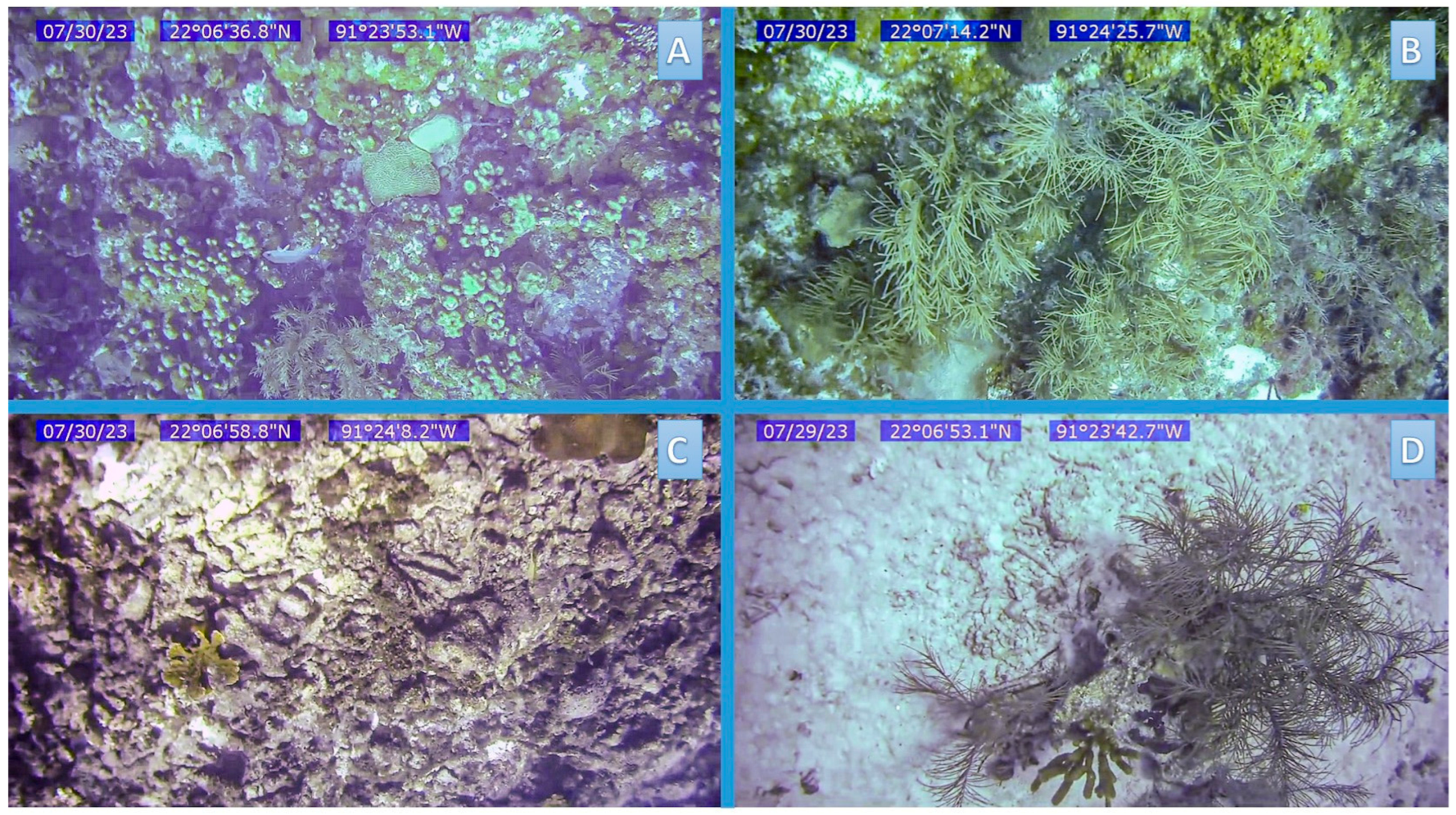

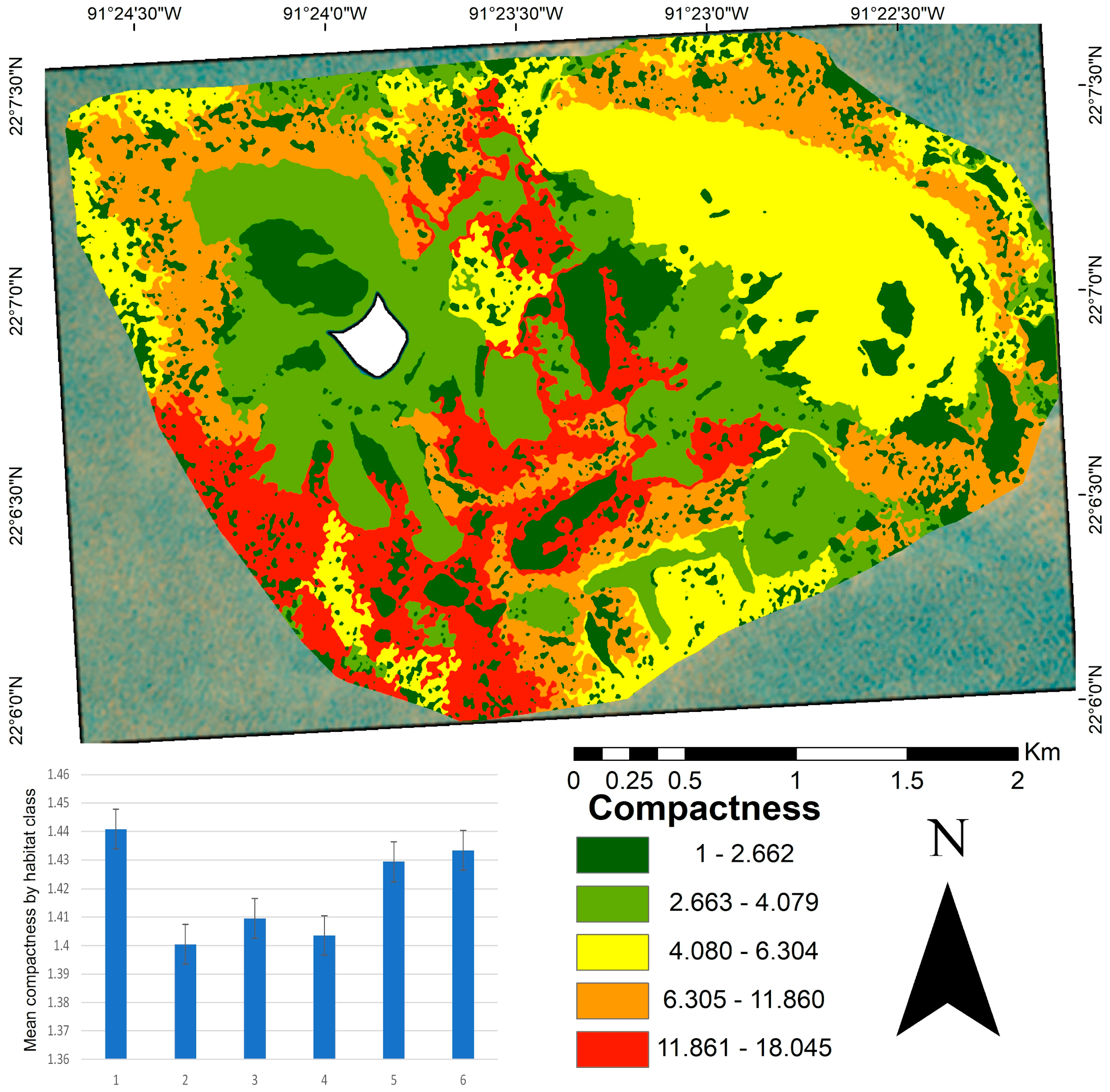
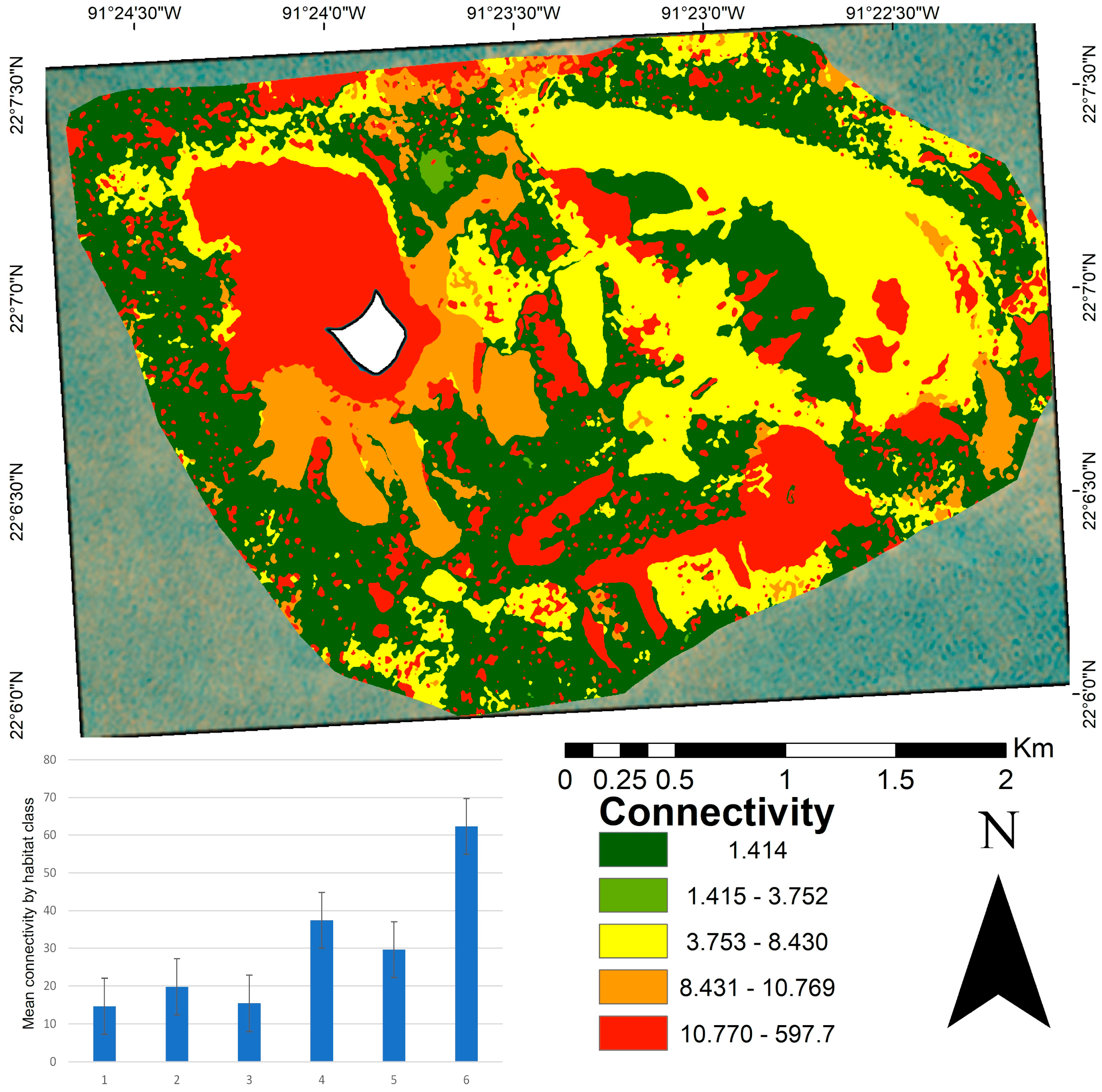

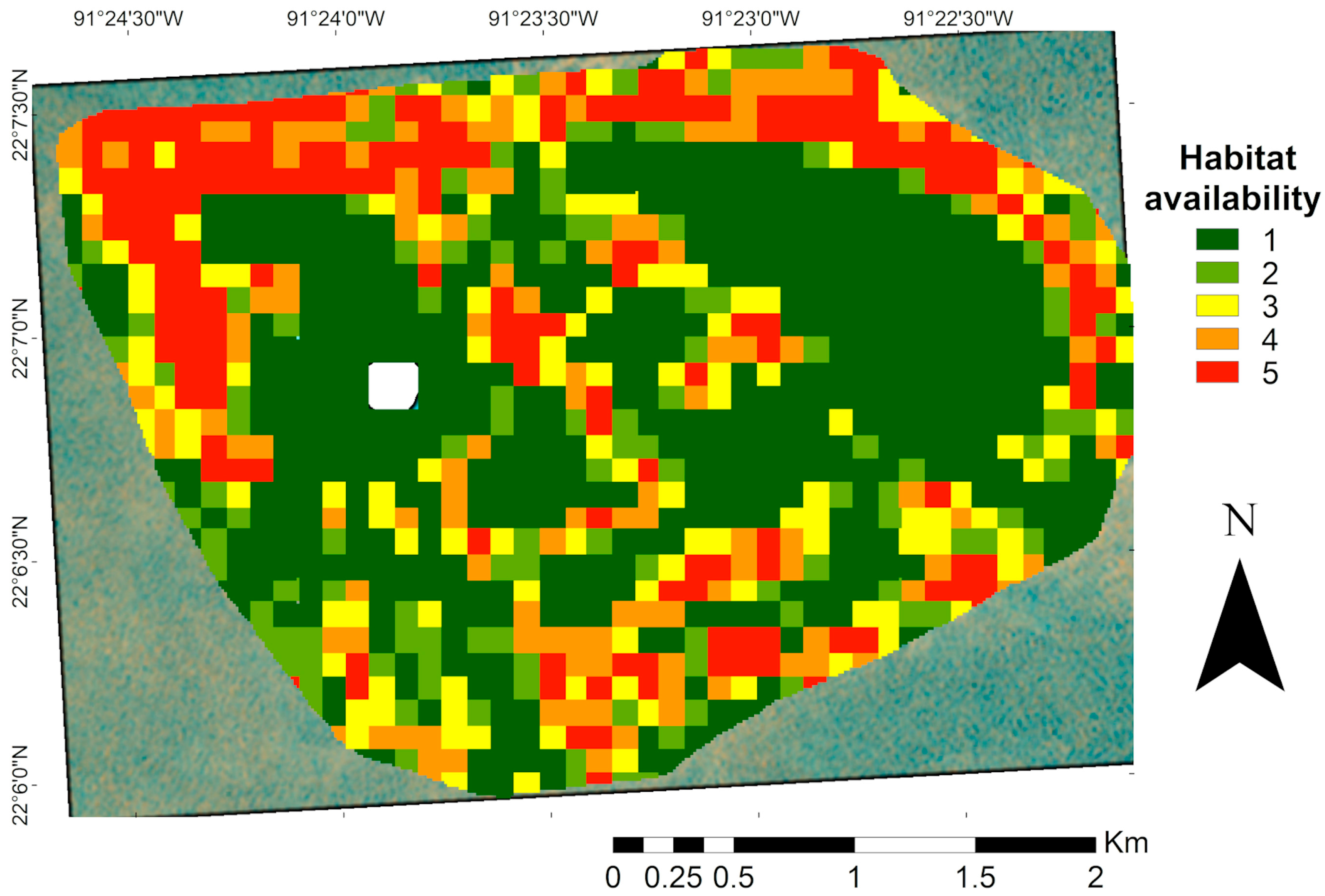

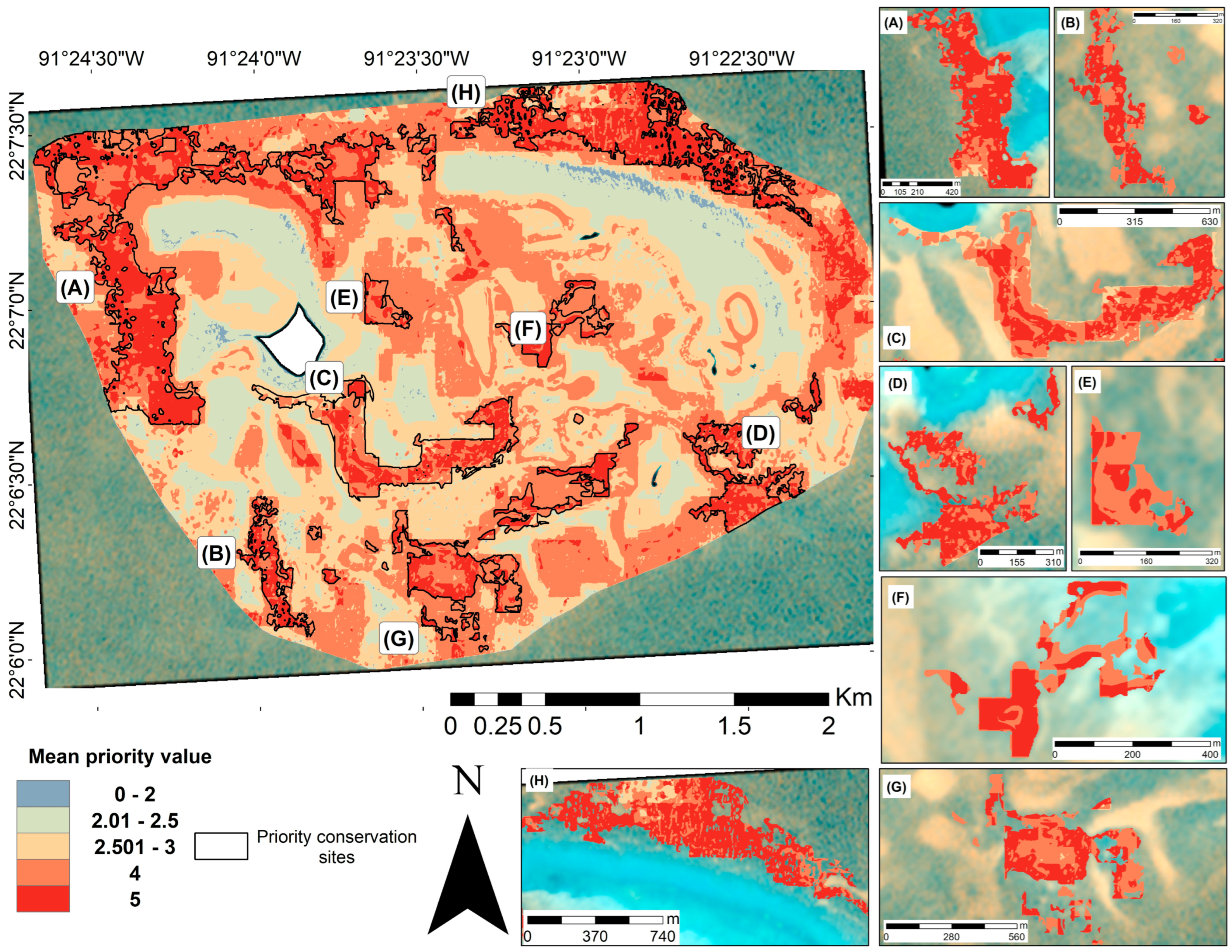
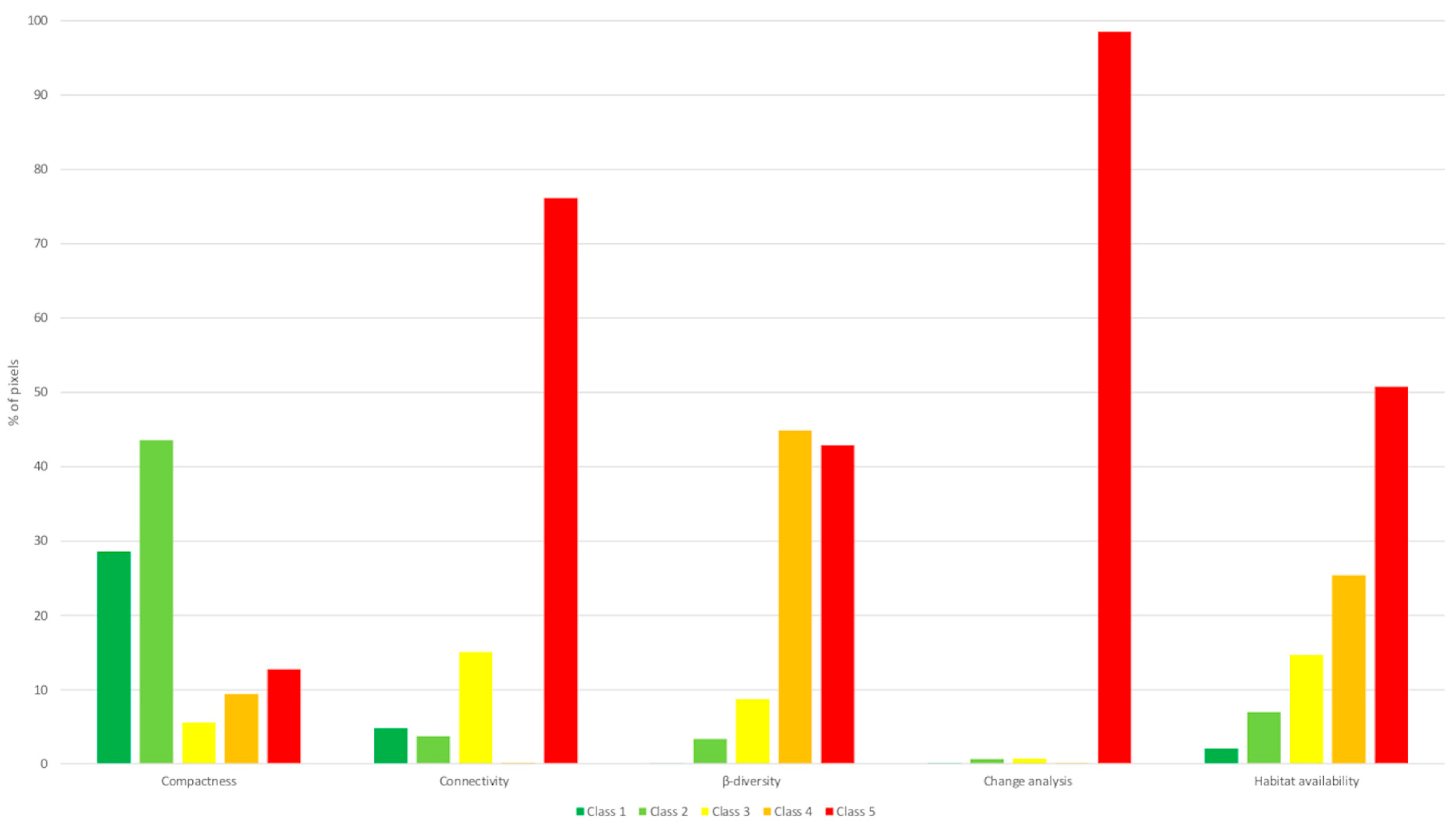
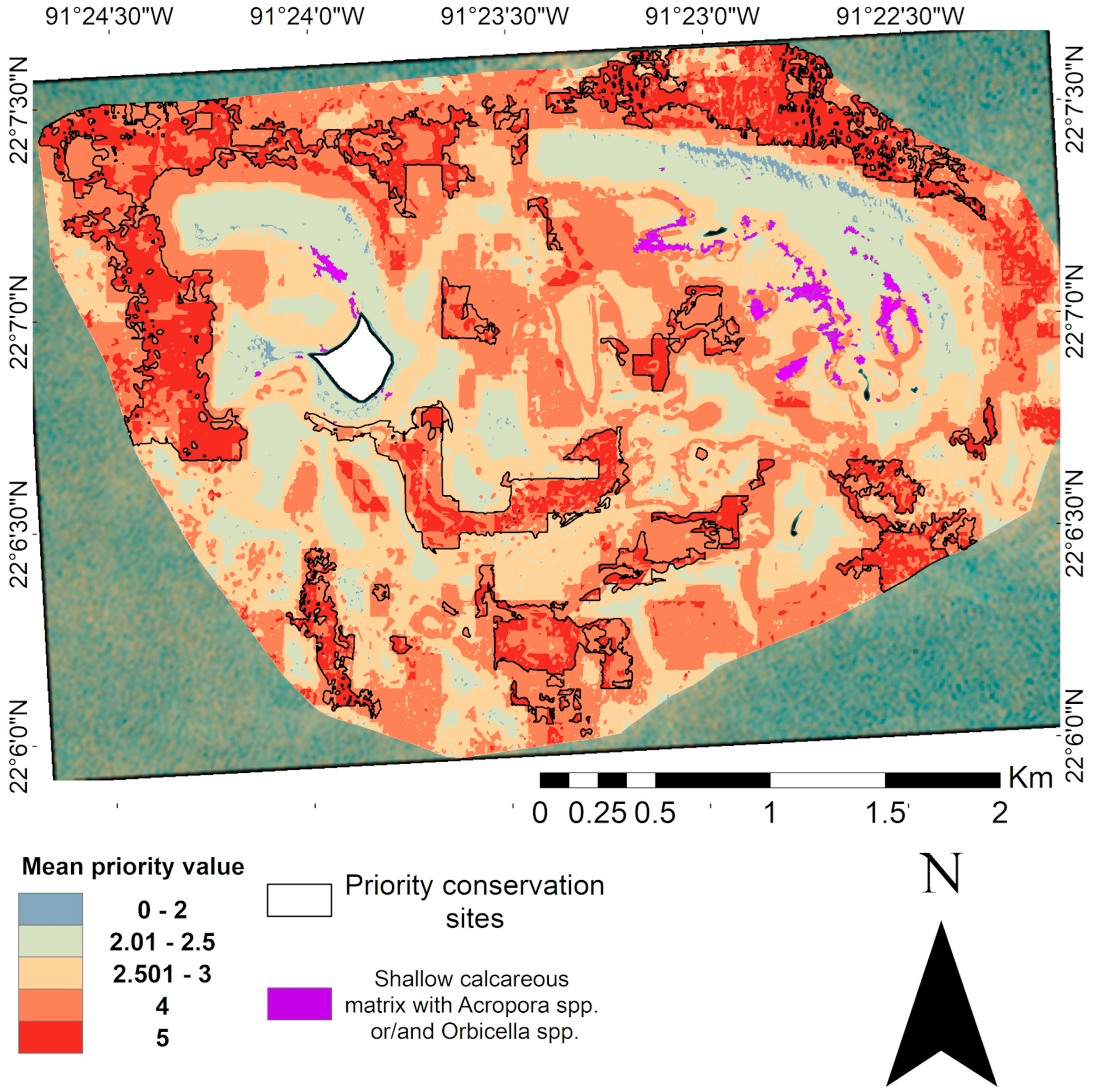
| Reclassification Value | Thematic Map | β-Diversity | Patch Compactness | Connectivity | Habitat Availability | Benthic Spatial Change |
|---|---|---|---|---|---|---|
| 1 | Deep sandy habitat | 0 | 11.83–18.04 | 10.77–597.79 | 1 | High coverage loss |
| 2 | Intermediate and shallow sandy habitat | 1–40 | 6.28–11.82 | 8.43–10.76 | 2 | Moderate coverage loss |
| 3 | Regions dominated by calcareous matrix | 41–80 | 4.07–6.28 | 3.75–8.43 | 3 | Moderate coverage increase |
| 4 | High coverage of calcareous matrix | 81–120 | 2.60–4.07 | 1.41–3.75 | 4 | High coverage increase |
| 5 | Moderate hard corals coverage | 121–200 | 1–2.60 | 1.41 | 5 | No coverage change |
| Class Number | Habitat Types | Descriptions |
|---|---|---|
| One | Moderate hard corals coverage with other components | This class exhibits a low to high coverage of calcareous matrix and hard coral cover, with a low coverage of octocorals, sand, and macroalgae. Located in deeper zones. |
| Two | High coverage of calcareous matrix with other components | This class exhibits a moderate to high coverage of calcareous matrix, low to moderate coverage of octocorals, and low coverage of hard corals, with low to presence coverage of sand and macroalgae. Located between shallow and deeper zones. |
| Three | Regions dominated by calcareous matrix with low presence of other components | Dominated by calcareous matrix, presence to moderate coverage of macroalgae, presence to low coverage of hard corals, octocorals, and sand. Generally located in shallow zones. |
| Four | Intermediate sandy habitat | Dominated by sand in areas between 12 and 19 m depth. |
| Five | Deep sandy habitat | Dominated by sand cover in areas deeper than 19 m. |
| Six | Shallow sandy habitat | Dominated by sand cover in areas shallower than 12m. |
Disclaimer/Publisher’s Note: The statements, opinions and data contained in all publications are solely those of the individual author(s) and contributor(s) and not of MDPI and/or the editor(s). MDPI and/or the editor(s) disclaim responsibility for any injury to people or property resulting from any ideas, methods, instructions or products referred to in the content. |
© 2025 by the authors. Licensee MDPI, Basel, Switzerland. This article is an open access article distributed under the terms and conditions of the Creative Commons Attribution (CC BY) license (https://creativecommons.org/licenses/by/4.0/).
Share and Cite
Frías-Vega, J.E.; Rioja-Nieto, R.; Barrera-Falcón, E.; Cruz-Vázquez, C.; Alvarez-Filip, L. Spatial Prioritization for the Zonation of a Reef System in a New Remote Marine Protected Area in the Southern Gulf of Mexico. Diversity 2025, 17, 708. https://doi.org/10.3390/d17100708
Frías-Vega JE, Rioja-Nieto R, Barrera-Falcón E, Cruz-Vázquez C, Alvarez-Filip L. Spatial Prioritization for the Zonation of a Reef System in a New Remote Marine Protected Area in the Southern Gulf of Mexico. Diversity. 2025; 17(10):708. https://doi.org/10.3390/d17100708
Chicago/Turabian StyleFrías-Vega, Juan Emanuel, Rodolfo Rioja-Nieto, Erick Barrera-Falcón, Carlos Cruz-Vázquez, and Lorenzo Alvarez-Filip. 2025. "Spatial Prioritization for the Zonation of a Reef System in a New Remote Marine Protected Area in the Southern Gulf of Mexico" Diversity 17, no. 10: 708. https://doi.org/10.3390/d17100708
APA StyleFrías-Vega, J. E., Rioja-Nieto, R., Barrera-Falcón, E., Cruz-Vázquez, C., & Alvarez-Filip, L. (2025). Spatial Prioritization for the Zonation of a Reef System in a New Remote Marine Protected Area in the Southern Gulf of Mexico. Diversity, 17(10), 708. https://doi.org/10.3390/d17100708






